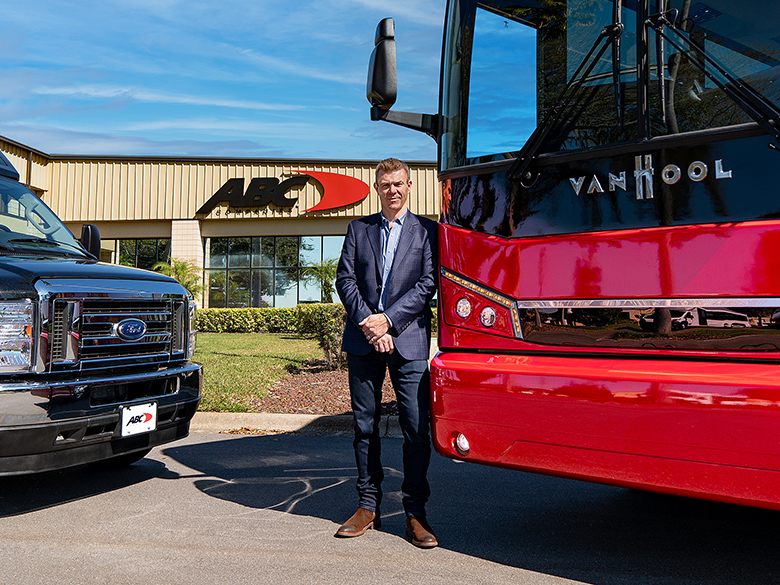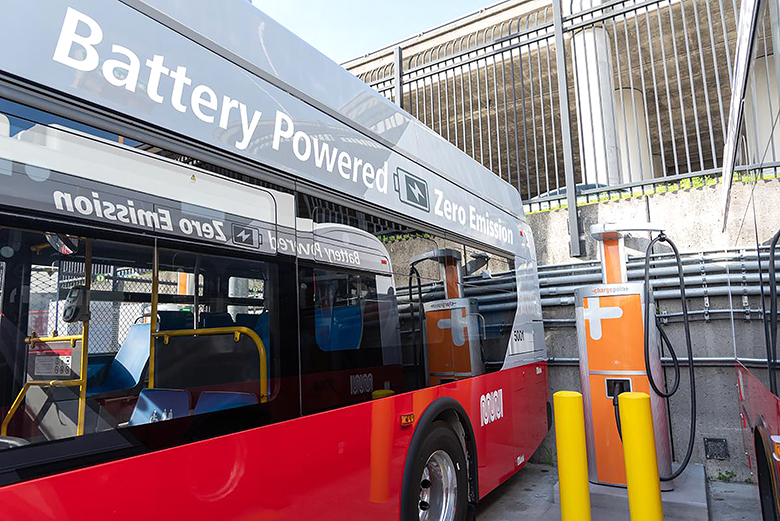COVID-19
- A New Age of Enforcement: Adjusting to Remote and Offsite Investigations & How to Prepare By:
Presented as part of ABA’s BISC & BusMARC 2021 Virtual Safety & Maintenance Series The American Bus Association’s Bus Industry Safety Council (BISC) and Bus Maintenance Repair Council’s (BusMARC) 2021 Virtual Safety & Maintenance Series offered a sequence of educational webinars early this year, covering a variety of industry-related topics. As part of its ongoing webinar series, the ABA hosted a virtual meeting with presenters Catterson Oh and Danielle Smith, transportation specialists with the Federal Motor Carrier Safety Administration’s (FMCSA) Compliance Division. Oh and Smith focused on COVID-19 national emergency investigative process updates including changes to the FMCSA investigative procedures due to COVID-19, recordkeeping and documentation as the result of COVID-19, and providing accurate documentation for FMCSA investigations. Changes to Investigative Procedures as a Result of the COVID-19 Health Emergency In May 2020, the FMCSA released guidance allowing investigators to conduct remote onsite investigations. These remote onsite investigations are intended to follow the same general process as offsite investigations with the exception that most of the investigation is now completed remotely. According to Oh, May 2020 resulted in a significant expansion to the FMCSA’s remote functionality. While motorcoach operators may not have seen any investigations in the last year, Oh noted that due to this expanded functionality, companies should expect a considerable increase in the number of investigations moving forward. “In terms of the offsite investigations with this pandemic, the policy with this particular type of investigation has not changed,” Oh said. “The offsite investigation will still be recommended for carriers that meet the appropriate criteria for this population of carriers.” Although carriers will not receive a rating from an offsite investigation, offsite investigations may be converted to onsite remote investigations under certain circumstances. Carriers with investigations that are converted onsite may be issued a Safety Fitness Rating. Overview of Investigation Process Safety Investigator (SI) will conduct an initial phone call with the carrier to introduce themselves, and review the reason for the investigation and next steps. 2. SI will email the carrier an Initial Contact Letter that will go over initial documents being requested. 3. Carrier will upload the initial documents to the Safety Measurement System (SMS). 4. After SI receives the initial documents, they may request additional documents via a Document Request Letter. 5. SI may contact the carrier via phone and email throughout the investigation. 6. Once SI has completed the investigation, they will request a closeout meeting with the carrier, which can be done via phone, Microsoft Teams, Skype, or other platform. 7. Carrier may receive a Safety Rating upon completion of the Remote Onsite Investigation. According to Oh, carriers subject to investigation will receive a phone call, followed by an initial contact letter, from an FMSCA Safety Investigator (SI) introducing themselves, the reason for investigation and next steps. Once a carrier has received this letter, that carrier’s information will need to be uploaded into the FMCSA Safety Measurement System (SMS). After receiving the initial documents, an SI will review the content to determine if additional documentation is required. If additional documentation is needed the SI will issue a “document request letter.” “This is where things start kind of diverting from the normal way of doing things,” Oh explained. “Especially when you have performed onsite investigations.” An SI will start contacting the carrier via phone and e-mail throughout the investigation. In a normal onsite investigation, the SI would be with the carrier in person to answer questions and provide additional guidance. Once the SI has completed their investigation, they will request a close out meeting with the carrier. This can be done over the phone or, more likely, in a video conferencing setting. At this point, the carrier may receive a safety rating upon completion of the remote onsite investigation. Once the SMS has processed the information, the carrier will be able to access their dashboard, track investigation progress, check due dates and required documents, view call-to-action reminders, upload documentation, and learn to use data to increase safety performance. After the SI has reviewed all of the required documents, they will send the carrier a request for a meeting to close out the investigation. Typically, this is done onsite, face-to-face however, since the onset of the pandemic, closeouts are now performed virtually. Reinstatement After Voluntary Revocation of Operating Authority In March 2020, the FMCSA issued multiple exemptions in response to the national health emergency. One of those exemptions included waiving the $80 reinstatement fee for carriers who opted to voluntarily revoke their Passenger Operating Authority. Carriers with a USDOT pin can login into their profile, update their registration information, and complete an MCSA-5889 form, a Motor Carrier Records Change. Carriers without a USDOT pin, can register and request a pin number through the FMCSA website. Before submitting a request, carriers will need to file a BOC-3 (Designation of Process Agent), confirm insurance filings are up to date, and make sure that their USDOT number is reinstated and activated. Once these items are completed, the reinstatement request is going to be put on hold until the carrier has everything submitted properly. “If all is submitted and you do have to pay that fee, then you’ll get it reinstated no later than the fourth business day after the payment is processed,” Smith explained. “You can request that the fee is waived, you’re just going to submit it through EMC’s e-mail address rather than doing it through the normal process online.” FMCSA Ratings The FMCSA issues three types of ratings. Satisfactory, conditional, or unsatisfactory. Satisfactory means that there are safety systems in place and they all appear to be working. Conditional means that there are safety systems in place, but there are breakdowns within some of those systems. While carriers are still able to operate with a conditional rating, some choose not to do so and would rather upgrade their score. Unsatisfactory ratings mean a carrier is considered unfit and are not allowed to operate after that time. “All of the critical violations are listed within the Read More >
Motorcoach
- Fisher Charter Service Stays Efficient with busHive By:
Founded in 1950 and built on three generations of family management, Fisher Bus Service has always placed an emphasis on the value of long-term stability and efficiency. Owner and operator, Ryan Fisher, says busHive helped his company accomplish just that. Based out of southeastern Massachusetts, Fisher Bus operates a mixed fleet of school buses, vans, motorcoaches, and miniature trolleys. The operate thousands of field trips, athletic trips and charters per year for school districts, corporate clients and universities. In an effort to update and streamline their services, Fisher Bus began working with busHive over seven years ago, moving from a pen and paper system to busHive’s more modern technology. Prior to adopting busHive, Fisher had been using Microsoft Word and Microsoft Excel to designate pickup and drop-off locations, providing drivers with sheets of paper as a way to navigate routes. “That actually worked for a long time, and it worked for the drivers that had been with us for a long time,” Fisher said. “But at some point, we brought in new work and new drivers, and we knew that we were going to need a better system to manage everything.” As Fisher began researching different companies, he came across busHive’s technology and found that their program presented the best solution for his organization’s needs. When faced with a multitude of choices for charter-management software, Fisher said that busHive stood out thanks to its ease of use and ability to consolidate disparate divisions of the Fisher Charter Service company. “The impetus behind utilizing busHive was that a lot of the features, dispatch, tracking trips, access to a professional format, the ability to share information with customers, were all consolidated in one place where all that information is kept, reported, facilitated to customers, and can be used by the various departments in the operation.” busHive develops cloud-based technology to streamline workflows and recordkeeping. The company’s charter management technology manages quoting, scheduling, billing and payroll. It also offers integrated solutions for tracking driver compliance and vehicle preventative maintenance. The system has a built in, fully integrated dispatching and scheduling display. With the click of a button, Fisher’s team can view a calendar and quickly see what equipment they have available each day. This prevents overbooking and allows for the adjustment of rates for high-demand days. Implementation and integration busHive utilizes a three-step implementation process: data import, configuration, and training. For the first step, busHive gathers a company’s work requirements and imports the operation’s local data into the system – customer names, phone numbers, addresses and emails; as well as vehicle and driver information. busHive’s configuration phase involves customizing the program to suit its client. Support staff imports personalized quotes and confirmations, invoices, billing rates and preferred dispatch display information into the system. Finally, busHive handles training based on responsibility. Most training is handled over the phone and web, but busHive can conduct on-site training as necessary. The average implementation is 30 days depending on whether custom development and reporting is required. “Technology integration can be a major headache – and just like with any software, it’s only as good as what you’re inputting into it,” Fisher said. “We initially piloted the software with the school bus division and once we understood the functionality, we brought on the motorcoach division.” Fisher Bus now utilizes busHive for quotes, confirmations, scheduling, and driver itineraries. Once a customer books a charter, busHive automatically generates confirmations for the operator. The software customizes contracts’ unique policies, terms, and conditions, specifically for Fisher Bus. “One of the best aspects for us is the consistency and professionalism with how our customers see a trip. All the information is right there. From the company to all the client’s information and the date, the itinerary is laid out perfectly, the terms and conditions that we have set for the clients is all available right there. It is very clean, very streamlined, and it all works very well into the system.” When the company runs a quote (and it is accepted by the customer), Fisher said that it is easy to go in and add a vehicle and driver to that particular trip. The driver is notified, and the trip’s date, time, pickup location, and destination are all instantly available to him or her. According to Fisher, the drivers and dispatch staff have also come to appreciate the instantaneous information generated by the busHive Driver Portal, as well as its flexibility. “It is such a seamless interaction between the office and the drivers,” Fisher said. “And once the drivers are fully incorporated into the system, it becomes great a tool for payroll and billing as well.” Service and Support When it comes to after-sale support, Fisher said busHive has provided exceptional service, either answering questions right away or, if the answer is not immediately available, working to provide a solution as soon as possible. “There has not been a time where we have had a problem with busHive that has been an outstanding issue and has not been cleared up,” Fisher said. “Their staff has done a wonderful job helping us out with any issues that we have. They are responsive and they take the time to help you out and try to solve your issues.” When it comes to working in an industry like motorcoach, Fisher said finding the right partners makes all the difference. “It’s not an easy business, but we’re happy to do it, and it makes it a lot easier when you get really good people working for you,” Fisher said. “That’s kind of the deal. Keep good people around and keep moving forward.”
Transit
- CapMetro Assembles Team to Revolutionize Bus Yard Automation By:
WSP joins Perrone Robotics, Texas A&M Transportation Institute and Clever Devices for deployment of a heavy-duty automated battery electric bus WSP, a leading engineering, environment and professional services consultancy, announces its groundbreaking partnership with Perrone Robotics, Texas A&M Transportation Institute (TTI), and Clever Devices to automate (Level 4) a 40-foot battery electric bus for the Capital Metropolitan Transportation Authority (CapMetro). This $1.26 million project is partly funded by a nearly $950,000 grant provided through the Federal Transit Administration’s (FTA’s) Advanced Driver Assistance Systems (ADAS) for Transit Buses Demonstration and Automated Transit Bus Maintenance and Yard Operations Demonstration Program, with CapMetro funding the remaining costs. As urban mobility evolves at an unprecedented pace, this first-ever venture of its kind, automating a heavy-duty battery bus in an active transit bus yard, represents a significant step towards enhancing the efficiency and safety of bus operations for all major metropolitan areas. Automated bus yard operations, a crucial component of modern transit systems, will revolutionize how buses are stored, operated, and charged. WSP is partnering with TTI to develop a market-first automation workforce analysis. Based on previous Transit Cooperative Research Program-funded research, the analysis will address how bus yard automation could impact existing roles and create demand for new positions. The project’s goal is to demonstrate how automated fleet technology can streamline bus yard operations. This would improve yard capacity by 20-25 percent, reduce costs, enhance safety, and shave an average of 15 minutes off daily pull-ins and pull outs for each trip amounting to tens of thousands of hours saved per bus depot, depending on fleet sizes and schedule requirements. “WSP is committed to shaping the future of zero-emission transportation,” said Severin Skolrud, vice president of emerging technology, transit, and rail at WSP. “New technology needs bold innovators to push boundaries and test the capabilities and challenges that are necessary for more scalable solutions, and CapMetro is taking that role head-on.” Throughout the initial phase, WSP will provide vital engineering support throughout. Phase 2 of the FTA deployment program may include retrofitting multiple heavy-duty battery electric buses (BEBs)—instead of a single heavy-duty BEB for phase 1—and developing the automated fleet dispatch software to remotely manage bus yard maneuvers. “While phase 1 will yield important results and provide valuable lessons, phase 2 will be the true test for retrofitting multiple automated electric buses and will yield more relatable results for transit operators to determine the technology’s ability to provide daily operational and safety benefits within the bus yard,” Skolrud said. The project is set to commence in the fourth quarter of 2023 and will be conducted at CapMetro’s North Ops facility in Austin, Texas. The results of this innovative pilot are expected to have far-reaching implications for the future of public transportation on a global scale. By pioneering automated yard operations, WSP, CapMetro, Perrone Robotics, Clever Devices and TTI are paving the way for a more efficient, sustainable, and customer-centric transit system in Austin and beyond.








